Even if you’re not a board gamer, chances are you may have played Werewolf (or Mafia), a party game that’s heavy on the psychological manipulation. The idea of the basic game is that roles are randomly (and secretly) distributed. Each “night,” when everyone closes their eyes, the werewolves wake up and pick a victim. During the “day,” all the players discuss and vote to lynch somebody, hoping to kill off a werewolf. The werewolves are hoping to finish off a certain number of victims, and the villagers are trying to rid the town of werewolves. There are countless variations on the game, some that introduce new characters with other abilities, but that’s the gist.
It’s a wildly popular game and you’ll often see people playing it at game conventions—it accommodates a large number of players, doesn’t require much more than a deck of cards or scraps of paper, and is quite engaging… unless you get killed off early on. Aye, there’s the rub: player elimination. Werewolf is most fun when you have a lot of people—but that also makes the game longer, and if you happen to be the first one killed or lynched (usually for no reason other than that the game must go on) then you don’t really get much of a chance to play at all.
So that’s where One Night Ultimate Werewolf comes in. Published by Bezier Games, It’s an intriguing spin on the game that plays quickly and eliminates the elimination. The title refers to “one night” because there’s only one round of play, and “ultimate” refers to the version that includes a bunch of other characters with abilities.
At a glance: One Night Ultimate Werewolf is for 3 to 10 players, ages 8 and up, and takes about 10 minutes to play. If you are planning to play with kids, I’ll mention that there isn’t anything terribly inappropriate in the artwork (the Troublemaker pictured below is as risque as it gets) but of course it is a game about werewolves and lynching, so keep that in mind. Also, the Tanner is a character who wants to die, and there’s also a Drunk who doesn’t know his own role, so that’s something to consider before you break it out with a bunch of third graders. It retails for $24.99.
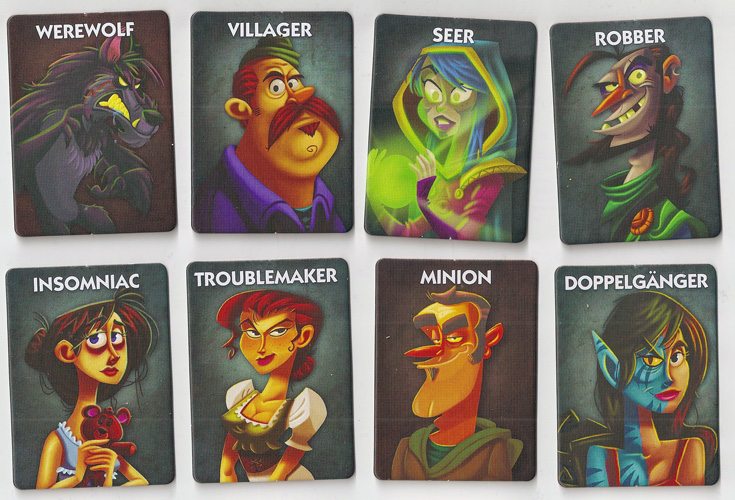
Components
The game components are pretty simple: 16 role cards, 16 role tokens. The cards, however, are actually card-sized cardboard tiles, and they’re nice and chunky. The tokens are also cardboard punch-outs, a bit bigger than a quarter, with the same artwork. Some of the tokens are also numbered, showing the order in which they act during the night. They’re double-sided as well, with the full-color artwork on one side and a lighter, muted version on the back.
The artwork by Gus Batts is great, with a style that looks like something from a cartoon movie or picture book. The box is a bit bigger than necessary to hold all of the bits, and for whatever reason the lid of mine is very tight and hard to open, but it’s pretty sturdy, like the bits.
How to Play
The goal of the game is to kill off one of the werewolves if you’re a villager, or prevent werewolves from being killed if you’re a werewolf. There are some other characters who have specific goals, but I’ll get to those.
Setup
To set up, you’ll gather a number of character cards—you can pick and choose which ones to include, and some will tip the balance in favor of the werewolf team or the village team. There are usually two werewolf cards, but you can mix it up however you like, including shuffling the whole stack and dealing them out without knowing what’s in the mix. Each player gets a card and looks at it secretly, and there are three more cards dealt face-down in the center of the table. (It’s worth noting that it’s possible for both werewolf cards to be in the center, which means that nobody is actually a werewolf.)
Night
During the “night” phase, several roles get a chance to perform an action. One player can act as the announcer to list the roles and provide time for them, or else you can use the free companion app (iOS or Android). Generally it’s good for somebody to be making a little bit of noise during this process, so that players can’t hear somebody picking up cards or moving around.
Day
Once all of the relevant roles have performed their night actions, then it’s “day” and everyone wakes up. You spend a little time discussing who you believe to be werewolves. You can say whatever you like, and use the role tokens to keep track of your story, but you cannot show your card to anyone. In fact, you can’t even look at your own card—which may have been switched during the night.
After a few minutes of discussion, there is a vote. On the count of three, everyone points at one other player. The player with the most votes dies and reveals their card. If there’s a tie, then everyone tied for most dies—unless nobody received more than one vote. For instance, if it’s agreed that there are no werewolves at all (because they’re in the center) then everyone could vote for the person on their right, thus ensuring that nobody dies.
Game End
The village team wins if at least one werewolf dies. Even if some villagers die as well, they can win posthumously because the villagers found at least one werewolf. If nobody is a werewolf and nobody dies, everyone wins. (Conversely, if nobody is a werewolf and a villager is killed, then everyone loses.) The werewolf team only wins if at least one player is a werewolf and no werewolves are killed. There are a few roles that mess with the win conditions, but I’ll explain below.
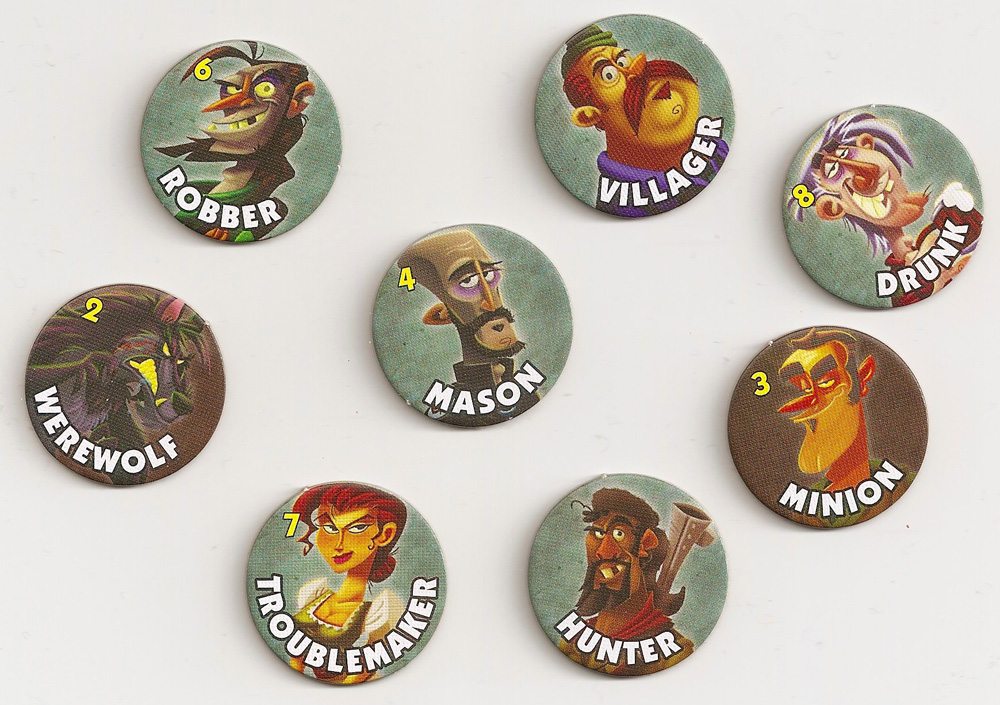
Here are the roles, plus their night actions, if any:
- Doppelganger—this character goes first, but is the most complicated to use. The Doppelganger gets to look at one other player’s card and then becomes a copy of that role. Generally I’d recommend leaving the Doppelganger out unless everyone’s familiar with the other roles.
- Werewolves—the werewolves get to open their eyes and look at each other so they know who they are. If there’s only one werewolf, the player may look at one of the center cards.
- Minion—the minion is on the side of the werewolves, and gets to see who the werewolves are, but they don’t know who he is. (The werewolves put their hands out with their thumbs up.) If the minion dies but no werewolves die, the minion (and the werewolves) win.
- Masons—there are two Masons, and they get to wake up and see each other.
- Seer—the seer gets to look at one other player’s card or two cards from the center.
- Robber—the robber may swap cards with another player, and then looks at the card they took. The robber joins the team of whatever card they took (without taking the role’s night action), and the player who now has the robber card is on the village team.
- Troublemaker—the troublemaker gets to swap two other players’ cards with each other, without looking at them. Those two players now become the other roles without knowing it.
- Drunk—the drunk exchanges his card for one from the center without looking at it. The drunk now becomes that new role, even though he doesn’t know what it is.
- Insomniac—the insomniac gets to look at their own card one more time, to see if their card has changed.
Finally, there are three roles that don’t do anything at night. The 3 Villagers have no special abilities. The Tanner hates his job and wishes he were dead, so he’s on a team by himself—he wins if he dies. The Hunter has a one-shot kill—if he dies, whoever he is pointing at also dies regardless of how many votes they got.
The Verdict
I’ve played traditional Werewolf before, but I was never a huge fan of it mostly because of the player elimination. At the beginning of the game you have to kill off people without having much information, and those players get to just sit around and watch. It’s part of the reason why games like The Resistance became popular—they capture a bit of that psychological manipulation but without booting players out of the game.
One Night Ultimate Werewolf scratches that same itch for me. You get to play around with deduction and persuasiveness but then it’s over in one round, and you can play again. Now, it does lose a little of the flavor because certainly in the traditional version there’s some tension that builds up over the course of several “nights” as you wonder who could be next to die. However, I think the lack of player elimination makes up for it. Designers Ted Alspach and Akihisa Okui did a good job of making the mechanics of the game and the different roles work within a single night.
That said, you still need the right group for the game. Some people just aren’t comfortable with (or good at) lying, and if they wind up with the werewolf card they have no idea what to say, which then makes it pretty easy for the village team to identify them during the day. To some extent, those who don’t mind making baseless accusations are going to do better than those who are unfailingly honest. And I suppose the downside of playing this with your kids is that you may be training them to fool you better.
However, if you like the idea of Werewolf but, like me, hated seeing players sitting out on the sidelines, give One Night Ultimate Werewolf a try. It’s a fun one to break out for variable size groups in between other games.
Click here to see all our tabletop game reviews.
![]() To subscribe to GeekDad’s tabletop gaming coverage, please copy this link and add it to your RSS reader.
To subscribe to GeekDad’s tabletop gaming coverage, please copy this link and add it to your RSS reader.
Disclosure: Bezier Games provided a copy of this game for review.
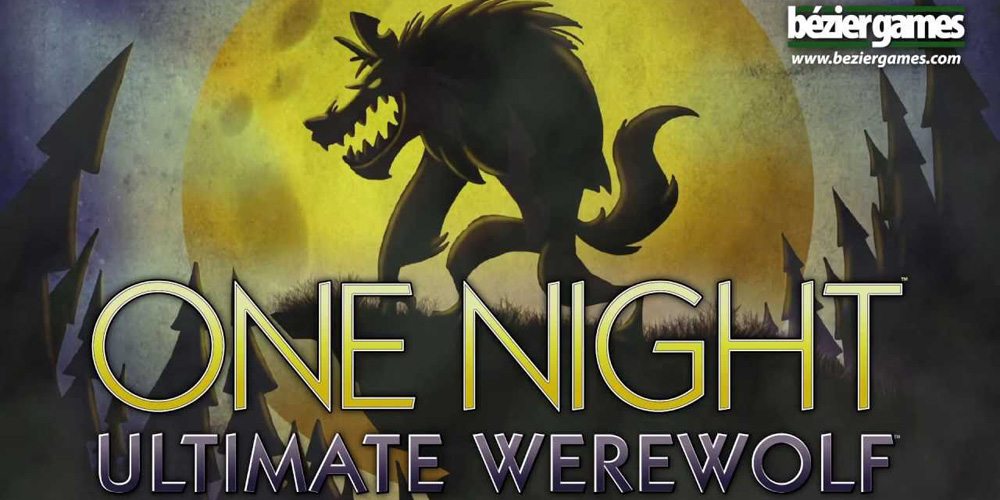
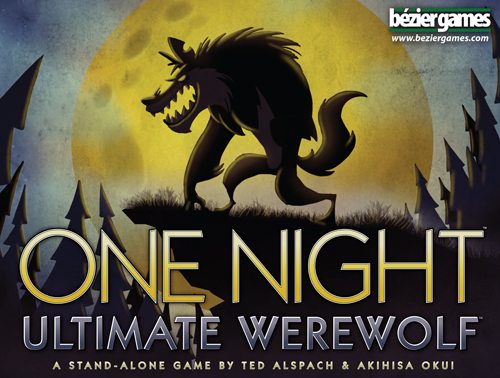



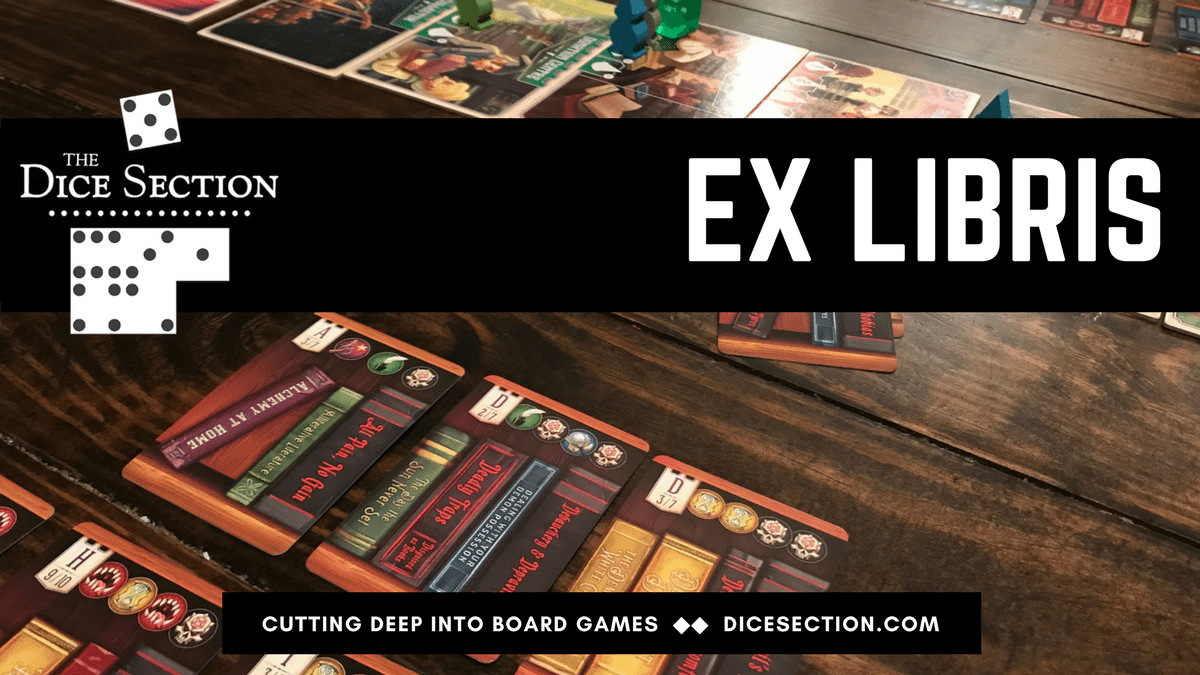

I loved playing Mafia in high school on long bus trips! Thanks for this Game review I can’t wait to play this with the fam!
I will note that because some of the roles involve swapping or moving around the cards, this game does require some place that everyone can reach where all the cards are placed. You could still do a bus-ride game but would have to leave out the Troublemaker and Robber, and maybe the Seer. The rest would be okay. Oh, but if there’s a lone werewolf they get to peek at one of the cards in the center.
You can play it for free: http://www.mediafire.com/download/bm4ounzaqixm3nl/One+Night+Ultimate+Werewolf+and+Daybreak.rar
thank you very much….